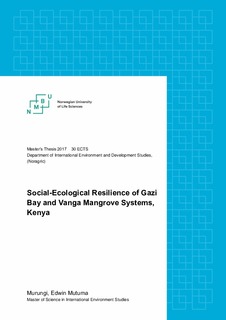| dc.description.abstract | Mangrove forests are important, yet sensitive and highly threatened coastal ecosystems that require careful management and utilization. This study assesses, compares and contrasts social and ecological resilience of two mangrove forests of Gazi Bay and Vanga and their adjacent coastal communities. Assessment was done on mangrove forests structure, key disturbances in mangroves and social systems, and changes in mangrove management regimes. Sampling was done in 10m*10m quadrants laid along belt transects perpendicular to the shorelines. Socio-economic data was collected using semi-structured interviews and household questionnaires, and further data was obtained from field observations and analysis of satellite images. A historical timeline for the two mangrove systems was created to give insight on disturbance regimes and to reveal changes in systems’ resilience over time. The results reveal that changes in mangrove management regimes have impacted resilience of mangrove systems differently. Damming of Mkurumuji River has led to loss of livelihoods and to death of Sonneratia alba trees at Gazi Bay due to excessive sedimentation. This is happening before the mangroves have had sufficient time to recover from a previous disturbance by clear cutting, presenting a major shock to the S. alba stand and fundamentally altering its state. Human population growth at Gazi Bay and Vanga is not causing a reduction in mangrove resource, as villagers are increasingly using concrete blocks as mangrove substitutes for building. Finally, pressure on Vanga mangrove forest is not due to local utilization, but due to harvesting for trade by traders living far away from the village. The study recommends that the government and other responsible stakeholders should commit to increasing people’s income-generating opportunities to reduce poverty and increase resilience of mangrove systems. Further, scientists and mangrove resource managers should recognise local knowledge and foster its complementarity with scientific knowledge. | nb_NO |

